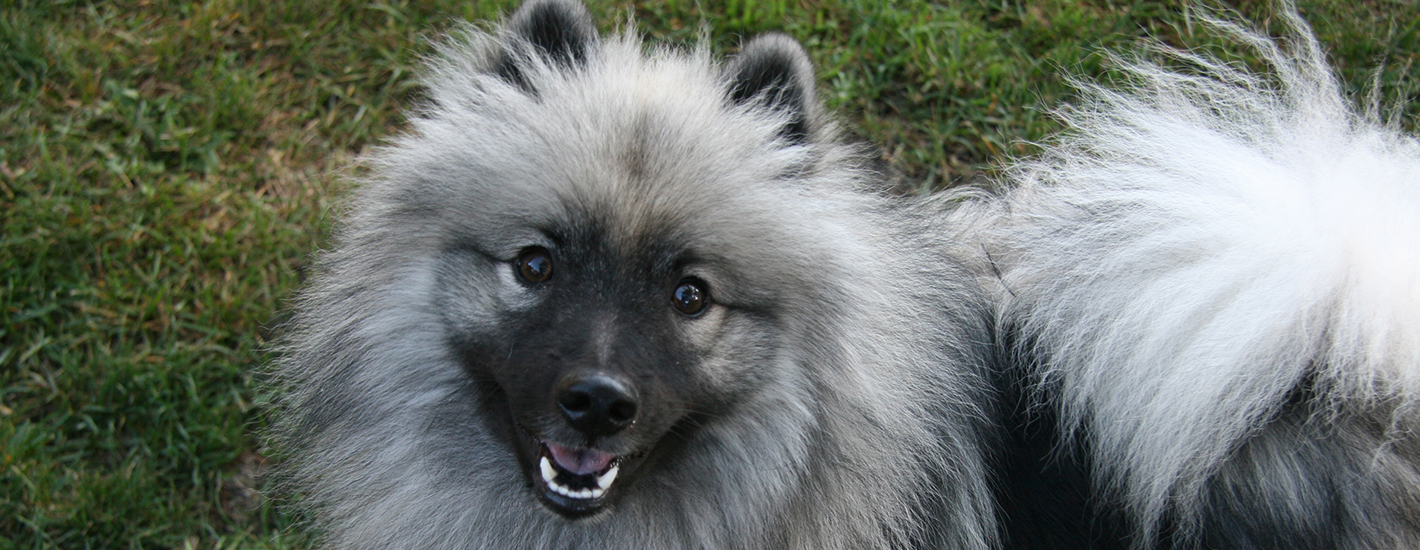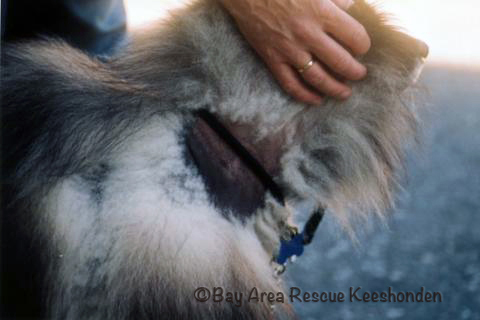
Will shaving a Keeshond keep him cooler in the summer? Will it make him shed less? Will it keep his coat from matting? You may be surprised to learn that these are myths!
Here’s our advice…
First, we’d like to explain a bit about the Keeshond coat, which is different than many other breeds. The Keeshond (like other plush-coated breeds, such as the Samoyed and Siberian husky) has a double coat. It consists of a soft, fine undercoat, and a harsher, longer “guard” coat. Together, the layers of the coat insulate the Keeshond and protect the dog from the sun and other hazards (such as thorns and insects.)
Most of the time, the Keeshond coat is in a resting phase, and isn’t growing. (This is different than single-coated dogs, such as poodles, whose hair is always growing.) Once or twice a year, the Keeshond “blows coat,” shedding the soft, thick undercoat, which may come out profusely in tufts. Then, the coat-growing cycle turns on, and the coat regrows. After it regrows, it goes back into the resting phase, where it stays until the next time the dog blows coat.
Hot weather
The Keeshond’s thick coat provides insulation, keeping the dog warm in winter, and cool in summer. Shaving the coat for the summer will actually make your Keeshond hotter! It also makes the dog prone to sunburn, and more susceptible to scratches and insect bites.
A matted coat prevents air from getting to the skin, which can cause skin infections and overheating.
The key to keeping a Keeshond cool and comfortable in summer is brushing the coat once a week (see our page on grooming techniques.) A well-brushed, mat-free coat lets air circulate to the skin, so the the soft undercoat can do its job of insulating the dog.
Shedding
Does a Keeshond shed? Yes! Mostly, it’s the soft, fluffy undercoat. The good news is, unlike the short, sharp hairs shed by many other dogs, the Keeshond’s coat doesn’t tend to stick into fabrics or carpets. Instead, the long, fine fur lies on the surface and brushes off easily.
A shaved Keeshond will still shed. But the cut hairs are sharp, and may behave more like the short, sharp hairs of other breeds, which embed themselves tenaciously into furniture and clothing, and are amazingly difficult to remove!
Brushing your Keeshond regularly will remove most of the loose undercoat, and keep the furry dust bunnies around your house to a minimum.
Mats
Will shaving your Keeshond prevent his coat from matting, so you can brush him less often? Not exactly! It can actually make matting worse. Here’s why:
The undercoat grows back faster than the guard coat. As the layers of coat grow at different rates, the slower-growing, harsher guard hairs get tangled in the wooly, faster-growing undercoat. Without the long guard hairs to protect the soft undercoat and shed dirt, the undercoat is more easily damaged, and sticks, leaves, and debris get stuck in it. The shaved coat gets matted and dirty more quickly, and needs more frequent brushing!
But it will grow back!
Or will it? Well… maybe. Or maybe not. The truth is, the coat may not grow back for a very long time, and it may never be the same.
If you look closely at a Keeshond’s coat, you’ll see that the tips of the guard hairs are black. The black tips determine most of the dog’s color – the longer the black tips are, the darker the dog. The undercoat (which is usually hidden under the guard coat) is cream or gray.
Shaving cuts off both the undercoat and the black tips of the guard hairs, leaving only gray or cream-colored coat. A shaved Keeshond loses his beautiful color!
As the coat grows back, it may be a darker color, and the texture or markings may be different. It may grow in patchy or thin, or the guard coat may not grow back. The coat may never look as elegant or feel as luxurious again.
Post-clipping alopecia
Shaving the Keeshond coat can also cause “post-clipping alopecia.” Why does this happen? There are several theories, but no one knows for sure. What we do know is, it’s a fairly common condition that can happen anytime the Keeshond coat is clipped.

The Keeshond in this photo had post-clipping alopecia when we rescued him. Someone had clipped around his neck, probably to remove a collar that was caught in his matted ruff. He had a bald strip several inches wide all the way around his neck! Imagine if they’d shaved the entire dog! He did finally grow coat, but it took a very long time.
He illustrates what happens with post-clipping alopecia: All of the coat in the clipped area falls out. The skin becomes completely bald and turns dark. There’s no effective treatment – you just have to wait. Most dogs grow coat back eventually, but it can be a year (or even longer!) before there’s any sign of hair. When it does grow in, the new coat may be darker in color.
The bottom line:
Veterinary dermatologists recommend shaving your Keeshond only when absolutely necessary (such as for surgery.) We agree. The Keeshond coat is really not hard to care for, and you don’t have to spend a fortune on groomers. Brushing the dog once a week (see our techniques page) will keep your Keeshond comfortable and looking gorgeous!